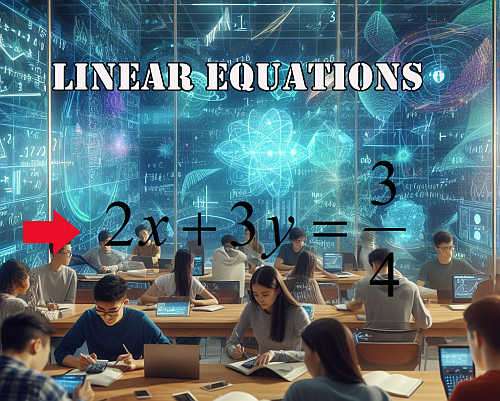Solving Linear Equations Calculator
Instructions: Use this linear equation calculator to solve any linear equation you want, of one or more variables . Please type in the linear equation you want to solve.
This Linear Equation Calculator
This linear equation calculator will allow you solve linear equations you provide, showing all the steps. For example, you may be interested in solving something like '1/3 x +1/4 y = 1/6', which is a linear equation with two variables, x and y.
Once you specified a valid linear equation you want to solve, then you can click on "Calculate" and you will be provided with corresponding steps needed to arrive to the solution.
Solving linear equation is the easiest among the broader task of solving polynomial equations, which can be a lot harder, especially for polynomial with a higher degree.
What is a Linear Equation
A linear equation is a math equation in which you have that both sides of the equation are linear expressions. A linear expression is the sum or subtraction of constants or constant multiplied by a variable.
For example, '2x + 3y = 1' is a linear equation, but '2x = cos(x)' is not. It is important to distinguish between a linear expression and a linear equation.
Following the same example, '2x + 3y' is a linear expression, but it is not a linear equation, because there is no equality involved. In order to have a linear equation, YOU NEED to have an equality sign in it.

Linear Equations Formula
A linear equation formula will depend on the number of variables we use. For example, the general linear equation formula for one variable x is:
\[\displaystyle ax + b = c \]Some will argue that there is no need to have a constant on the left side, and they would write:
\[\displaystyle ax = c \]Now, the general linear equation formula for two variables x and y is:
\[\displaystyle ax + by = c \]In general, the general linear equation formula for \(n\) variables is:
\[\displaystyle a_1 x_1 + a_2 x_2 + .... + a_n x_n = c \]Notice that we put a "+" in general, but the constants \(a_1\), ..., \(a_n\) can also be negative.
How to Solve Linear Equations
- Step 1: Make sure you are dealing with an actual linear equation. Then, identify how many variables are involved in the equation
- Step 2: If you have only one variable, say x, you can solve for x, manipulating the terms of the equation, putting x on one side and then solving for x. Solving for x in this case is expected to lead to a numeric solution
- Step 3: If you have more than one variable, then you choose one variable, say x, and then solve for x, in terms of the other variables. Here you don't get a numeric solution, but instead, you get x (or whatever variable you chose) in terms of other variables
Observe that we are dealing here with one linear equation. You can use this system of equations calculator if you are dealing with multiple linear equations.
Having an equation calculator with steps can prove to be extremely useful, as it is sometimes hard to find the correct strategy to use for certain equations. Of course linear equations are simple, but we can find that solving polynomial equations, or solving trigonometric equations, for example, can be tremendously laborious and challenging.
How do you find the linear equation?
Linear equations appear naturally in algebra problems and all sorts of algebra equations. Linear functions are extremely common both in Algebra and Calculus and will appear literally EVERYWHERE.
You can, for example, use the slope intercept form or the point slope form to calculate a linear function. Usually, you will work the linear equations in standard form, which the way we presented before:
\[\displaystyle a_1 x_1 + a_2 x_2 + .... + a_n x_n = c \]Normally, we don't work with n generic variables, we work with two or three variables, which would look like:
\[\displaystyle a x + b y = c \] \[\displaystyle a x + b y + c z = d \]respectively.

Advantages of working with Linear Equations
- Step 1: Linear equations are simple! They are easy to calculate and easy to interpret
- Step 2: There are no tricks needed to solve a linear equation: pass the terms with to one side, group them and simplify
- Step 3: Linear equations are very common, and have a clear graphical interpretation
Naturally, if we could choose, we would always work with linear equation, but unfortunately reality is not that generous, as it the case that very frequently we will need to deal with equations more difficult than linear equations.
How do you know if a function is linear?
Fractions are one of the corner stones of algebra and of any general algebraic expression to calculate. Fractions are simple operands, but which can be compounded into more complicated terms using operations like sum, multiplication, etc., and then using functions we can construct even more advanced expressions.
The center of all algebraic calculator starts with the power of basic numbers of fractions.

Example: Solving linear equations one variable
Solve the following: \(\frac{1}{3} x + \frac{5}{4} = \frac{5}{6}\)
Solution:
We need to solve the following given linear equation:
\[\frac{1}{3}x+\frac{5}{4}=\frac{5}{6}\]The linear equation has only one variable, which is \(x\), so the objective is to solve for it.
Putting \(x\) on the left hand side and the constant on the right hand side we get
\[\displaystyle \frac{1}{3}x = -\frac{5}{4}+\frac{5}{6} = -\frac{5}{12}\]Now, solving for \(x\), by dividing both sides of the equation by \(\frac{1}{3}\), the following is obtained
\[\displaystyle x = \displaystyle \frac{ -\frac{5}{12}}{ \frac{1}{3}}\]and simplifying we finally get the following
\[\displaystyle x=-\frac{5}{4}\]Therefore, the solving for \(x\) for given linear equation leads to \(x=-\frac{5}{4}\). This concludes the solution calculation.
Other useful equation calculators
Using an equation solver can completely come in handy, especially when dealing with difficult equations. The case of linear equations is truly reduced to a class of simple equations to solve, and you will find equations that will be a lot more challenging.
Coming next in terms of difficulty you will find the polynomial equations, for which you can use a methodology which ensures you have the best chance of finding as many solutions as possible, but you are not guaranteed to find all of them at times. This polynomial calculator will guarantee you get as many solutions as possible.
Then you have the even more complicated of non-polynomial non-linear equations, for which you need to come up with an astute approach usually, if you want to come closer to the solution. Trigonometric equations are notorious for being difficult and reliant on a precise substitution.


